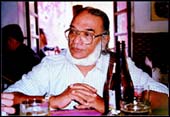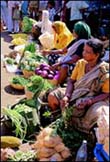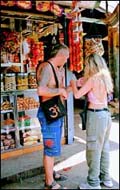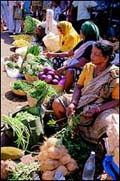


 If it's a Friday it must be the Mapusa Market
If it's a Friday it must be the Mapusa Market
|
|
If it is a Friday and you happen to be in Goa, it must be Mapusa. On that day everybody in Goa - and ones even beyond, from Banda, Sawantwadi, Kudal up north in Maharashtra and on occasion from the hilly tracks of Jamboti or Malwan and Tendul the ancestral village of Sachin Tendulkar - you know who... looks forward to a trip to Mapusa.
History books mention that large caravans of oxen were used in the trade across the Ghats. Historian Teotonio de Sousa mentions in his book Goa To Me that a man called Manoel Luis from Parra, a village near Mapusa, was one of the chief caravan owners with about seventy oxen of his own. The traders were known as Ghatkars because they crossed the Ghats to procure their goods. They made five or six trips to and fro in good weather and stopped for the night at safe places.
Once, it was Mapusa for cereals, fish, cattle, cloth, implements and what have you and Banastari, on the road from Old Goa to Ponda, again on Fridays, for banns, copper receptacles of all shapes and sizes and for all imaginable purpose. From the fabled banns sold at the fair, the little village, a fortified township of the Sultan of Bijapur at one time, derived its name - Banastari, i.e. the tar, the anchorage, where the copper vessels, the banns landed and were sold.
Mapusa also is the city of miracles. Miracles have been happening in Mapusa from time immemorial. The earliest go back to the times of Kaneshwara Baba, popularly known as Bongini and Bodgeshwar, a god whose happiness was to grant the vows of his devotees: a child to an anxious married couple, and to all others relief from physical and mental ailments, and from financial troubles. Kaneshwar Baba�s mandir was built in an open field, amid much greenery, the openness of the field and the greenery symbolising the boundless of god�s munificence.
Then, came the Portuguese and they built a church, in 1594, dedicating it to Our Lady of Miracles. To the Hindu the new dispenser of miracles could only be a sister of the famous Lairai, a goddess venerated for her compassion and generosity. At Sirigaon, a village in Goa�s mining belt, the devotees, the Dhonds, manifest their faith in the goddess walking barefoot on fire on the jatra of Vaishaka Shudha Panchnami.
They purify themselves weeks before the festival and sustain themselves during those days on a spartan diet of rice and vegetables, devoid of oil and even such taste-additives as onions and garlic. They also refrain from evil actions and thoughts. As time went by, our Lady of Miracles became the universally accepted tutelary saint of the town. Just like Banastari, Mapusa is a place-name with onomatopaeiac roots.
Once, it was a huge open market, principally of grain and cereals. As each measure (maap in Konkani, the regional language),was filled and emptied, the shop assistant yelled a throaty sale, and the man at the cash box kept track and registered the sale. So did Mapusa, one is told, earn its name and reputation for business: from countless measures filled, bought and sold: Map-sa. But anthropologists reject outright that etymology and have one of their own.
The original word, they say, was Mahapasaita, maha meaning big and passaita, a land granted to the administrative officer in return for services granted. It was, it seems, too unwieldy a word for the Portuguese and they simplified it, to begin with, Mabussa and eventually to Mapuca, with a �c� with cedila, which, since Goa�s merger with India in 1961, has been changed to �s� because there are no diacritical signs in English.
In course of time Mapusa became the largest trading centre in north Goa, and its Friday fair a weekly assemblage of farmers,peasants and artisans, who bartered produce for their requirements: a dozen eggs for a yard of denim, a bamboo basket for a measure of rice. And the Dhangars, the tribals from the Konkan, exchanged maunds of clarified butter for millet, trinkets and tobacco.
Mapusa was also the site of a grand cattle fair, Goa�s version of Pushkar. Breeders from the ghats walked for miles with their cows, bulls and buffaloes, wading rivers, crossing hills and forests and chasing the tigers and serpents on their path, in the sure knowledge that they would get a fair deal at Mapusa. It was well worth the risk and the bother.
As time went by, the Mapusa fair became a great social catalyst. Acquaintances casually struck, between buyers and shoppers, eventually bloomed into lasting friendships. And the Raibaris, the marriage brokers, a semi-professional lot, had a busy time. Many married Goans owe their happiness to the Mapusa fair and they proudly acknowledge it. And as Goans must, they lustily celebrate it. Where else! The shopping over, they converge in taverns spread all over the fair and nostalgia then takes over and euphoria follows.
By now the Mapusa fair is a tourist attraction. The King of Jordan saw it from a distance, David Niven �saw it and loved it,� but was �overpowered by the acridity of the spices�. Raj Kapoor wanted to use the fair as a film locale and as celebrities go, the good and the bad, the fair was where, sleuths believe Charles Sobraj met some of his accomplices.
|

Home Page
About the mag
Subscribe
Advertise
Contact Us



